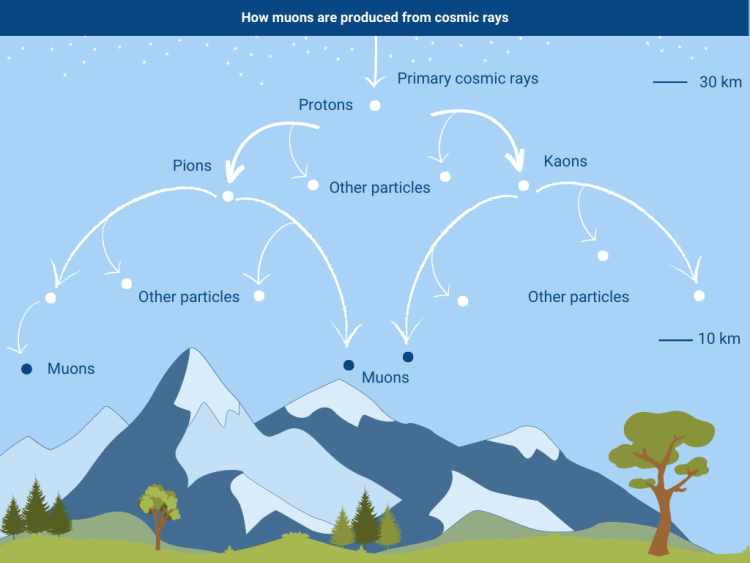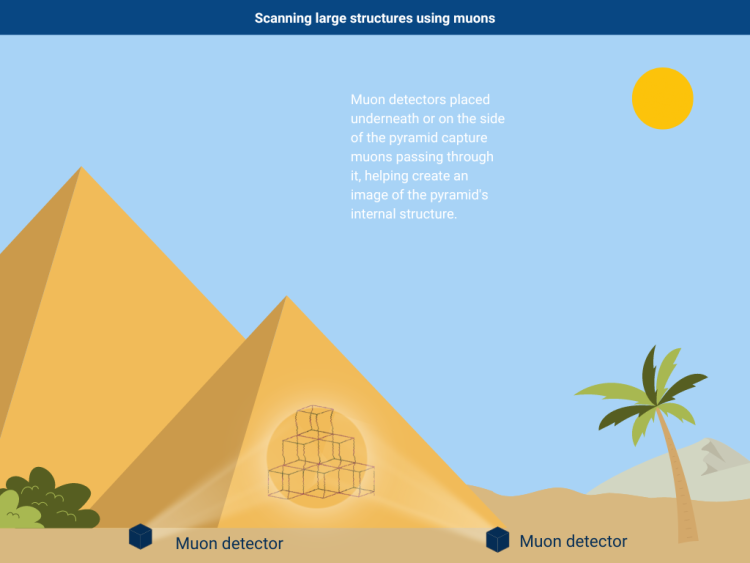Last month, Egyptian officials revealed the first footage of a hidden corridor inside the 4 500-year-old Great Pyramid of Giza, located on the outskirts of Cairo. Nine metres long and two metres wide, the mysterious corridor was first detected in 2016 thanks to muon imaging. Muon imaging is a non-invasive technique which uses cosmic ray particles, called muons, to see inside solid objects, detecting changes in density and composition, and therefore enabling scientists to create 3D models of their interiors. A recent IAEA publication, Muon Imaging, focuses on how muons are used as a non-destructive testing tool, enabling experts to make accurate three-dimensional images of what lies inside large structures, from the outside.
What are muons?
Our universe is filled with countless cosmic rays that sweep through space at nearly the speed of light. They are emitted by the sun or come from supernova explosions in distant galaxies. Every second, the Earth is bombarded by these rays, consisting of trillions of sub-atomic particles. When cosmic rays collide with our atmosphere, some of them are deflected by the planet's magnetic field, while others reach us here on Earth - without causing any harm. As the rays pass through the atmosphere, they undergo a series of reactions, creating a shower of new sub-atomic particles. Among these are muons.

Cosmic rays crash into the Earth's atmosphere, creating a stream of new particles, among them muons. (Graphic: A. Vlasov/IAEA)
Muons are puzzling, because some of their properties deviate, subtly but significantly, from the predictions of the leading theory of particle physics, known as the standard model. Yet scientists have found a way to use the mysterious particles, which resembles conventional radiography, to look deep inside large objects where physical access is not possible, such as ancient buildings, volcanoes or even nuclear reactors.
"Even though we can't see them, muons are everywhere on Earth: they continuously pass through us and objects around us at almost the speed of light from all angles," said Ian Swainson, a Nuclear Physicist at the IAEA. "They are completely harmless to people but can penetrate hundreds of metres of rock to provide a versatile means for understanding the composition and dimensions of materials which would otherwise be invisible to us."
"Muon imaging works in some sense like X-ray or gamma ray radiography, which is used in medicine to scan the body and in industry to assess the integrity and safety of structures and components," added Andrea Giammanco, Particle Physicist and one of the authors of the new publication. "But while those types of radiography rely on intense artificial sources of radiation produced by particle accelerators or radioactive sources, muon radiography is based on cosmic rays that come naturally from outer space."
There are two general types of muon imaging: muography and muon scattering tomography (MST).
Muography involves placing a detector underneath or on the side of a structure to capture the muons passing through it. The denser the material, the more muons will be absorbed. Some of the particles that manage to traverse the structure will be caught by the detector on the opposite side. In the resulting image, empty spaces through which muons pass easily will be marked as bright spots, while materials with higher densities will be darker.
Whereas muography relies on the absorption of muons by materials, muon scattering tomography (MST) is based on how muons are scattered. For example, using two detectors positioned on two opposite sides of a car or a shipping container, experts can track how the particles are deflected from high-density materials with a high number of protons, making it possible to look inside the vehicle or the container without the need for physical inspection.

Muography. (Graphic: A. Vlasov/IAEA)
The IAEA's new publication describes in detail the main techniques of muon imaging and the different types of detectors involved. It also covers a wide range of applications: from examining modern and ancient buildings, volcanoes and industrial structures to enhancing nuclear security and safeguards. "Representing a comprehensive overview in the field of muon imaging, this publication is useful to readers in industry and academia to get a deeper understanding of this developing field," Swainson said.
Since the first experiments carried out in the 1950s, muon imaging has been applied to a large variety of objects across the world. Muography is currently being used to evaluate the internal structureof the Vesuvius volcano near Naples, Italy, which tragically destroyed the ancient Roman city of Pompeii and several other settlements in 79 AD. Researchers are working to visualise the inner processes of Vesuvius with muon detectors in an attempt to improve their modelling, which is paramount for predicting any potential eruption and its course, as well as develop steps to reduce risks to the local population. The volcano has been inactive since its last eruption in 1944.
Similarly, muon imaging has been applied to scan the ancient city wall of Xi'an in China, a cyclone passing over Japan, glaciers in the Alps and recently a nuclear reactor in France that is undergoing decommissioning.
The IAEA plans to hold a workshop, titled 'Muon Tomography: From Basic Principles to Practical Usage and Applications' next year. The participants will discuss the various modes of applying the technique for practical applications, the properties of the detectors used, the algorithmic reconstruction of muon tracks, as well as data analysis and picture reconstruction.
The publication Muon Imaging can be found here.






